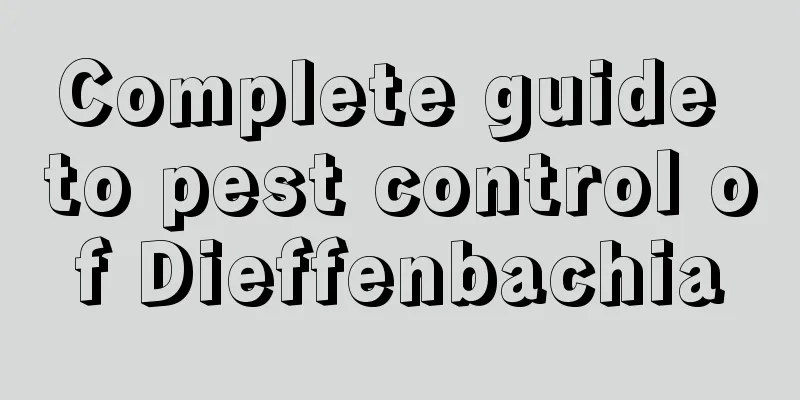Complete guide to pest control of Dieffenbachia

Leaf spotThis disease occurs on the leaves of evergreen and is more likely to occur in humid weather. The lesions are small brown spots at first, with the edges fading to green as if soaked in water, and then expanding in a ring-like pattern, circular to oval in shape, with brown edges and grayish white inside. In the later stage, dark brown mold spots appear in the center of the lesions, which turn into dark brown mold layers under humid conditions.
Disease patternBacteria can be spread through cuttings, contact, splashing water droplets, and seeds may also carry bacteria; The pathogen can survive for 3 months in moist soil; The disease is more likely to become serious when the greenhouse is too densely planted and grows rapidly, and the disease is more serious on the old leaves at the bottom of the plant and when it is warm and humid; High nitrogen, high phosphorus and low calcium are conducive to the disease, while high potassium, low phosphorus and high calcium suppress the symptoms. Prevention and treatment methodsThe method to prevent and control this disease is to remove diseased and damaged leaves in time; 0.5%-1% Bordeaux mixture ( or 1000 times diluted 50% carbendazim ) can be sprayed in the early or late stages of the disease. anthraxThis disease also occurs on the leaves of evergreen ivy, and in severe cases can spread to the petioles. The lesions initially appear as small water-soaked yellow spots, which expand to become oval to irregular brown or yellowish brown with slightly ring-like shapes. In the later stages, the lesions become connected and dry, and small black spots arranged in ring patterns appear. The main cause of this disease is poor ventilation, which is conducive to its occurrence when there are scale insects. The method to prevent and control this disease is to strengthen maintenance and increase the application of phosphorus and potassium fertilizers; in the early stage of the disease , 0.3%-0.5% equal-volume Bordeaux mixture ( or 800-900 times solution of 60% Mancozeb , or 1500 times solution of 70% Thiophanate ) can be sprayed. Brown Soft ScaleThis insect has a complex diet and can harm many plants, and evergreen is one of the flowers it harms. When brown soft scale insects harm plants, they generally gather on the leaf surface or young leaves, sucking the sap of the plants and excreting mucus. Their excrement can easily cause the proliferation of sooty mold bacteria, causing the stems and leaves to turn black, affecting the photosynthesis of the plants, resulting in weak growth, yellowing of leaves, and hindering the viewing experience. When the infestation is severe, the branches and stems are covered with insect bodies, causing the plants to wither and turn yellow, affecting their growth. Prevention and treatment methods:① If there are few plants or a few insects, you can usually scrape the insects off with bamboo strips or other objects; ② During the nymph hatching period, you can spray 1000 times diluted 40% dimethoate emulsifiable concentrate , or you can spray 1000 times diluted 5% phosmet emulsifiable concentrate to kill them. |
<<: Common diseases of lucky bamboo and their prevention and treatment methods
>>: Common diseases and pests of Datura
Recommend
How to prune Vinca rosea
1. Pruning before flowering Pruning is required d...
How to prune Japanese crabapple
Japanese crabapple pruning time Japanese crabappl...
Disease and Pest Control of Potted Orchid
Sheath Rust This pathogen mainly attacks the uppe...
How to cultivate Thousand Buddha Hands
How to grow Thousand Buddha Hands Thousand Buddha...
How often should Podocarpus be fertilized and what is the time and method of fertilization?
How often should Podocarpus be fertilized? 1. Dur...
What kind of soil is good for growing Clivia
1. Types Clivia likes warm and semi-shaded places...
Why do sunflowers face the sun? Do they turn their heads back at night?
1. Why face the sun? It contains a special auxin ...
What kind of flowerpot is suitable for goldfish spider plant
What kind of flowerpot is suitable for goldfish s...
How to prune the beauty plum
When to prune the plum tree The beauty plum is us...
Does Jerusalem artichoke prefer shade or sun?
Does Jerusalem artichoke prefer shade or sun? Jer...
Gerbera varieties classification
Main classification of gerbera Potted type The ma...
What is the best month to plant ginger? When is the best time to plant ginger?
What month is suitable for planting ginger? Gener...
How to care for succulents indoors?
Succulents have quickly become the darling of mod...
How to grow foxtail orchid and what to plant it with
1. Planting method 1. Seeds: Sowing can be chosen...
Cultivation methods and precautions of star flower
How to grow star flower Watering Star flower does...









